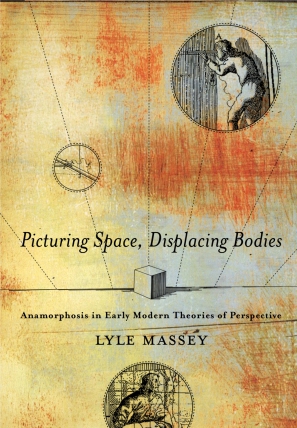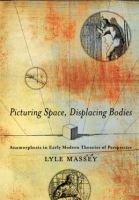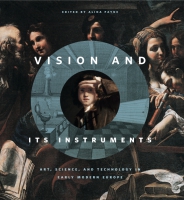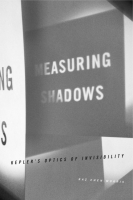
Picturing Space, Displacing Bodies
Anamorphosis in Early Modern Theories of Perspective
Lyle Massey
Picturing Space, Displacing Bodies
Anamorphosis in Early Modern Theories of Perspective
Lyle Massey
“This is a strong, well-articulated argument for the place of embodiment and bodily experience in Renaissance perspective. Lyle Massey is a very unusual scholar, well informed about phenomenological, Lacanian, and structuralist readings of perspective, but just as conversant with the history of geometry and its connections to Enlightenment philosophy. This book is a tonic, just what the field needs to restore some balance and help heal the rift between post-structuralist, psychoanalytic readings and technical, geometric interpretations.”
- Description
- Reviews
- Bio
- Table of Contents
- Sample Chapters
- Subjects
“This is a strong, well-articulated argument for the place of embodiment and bodily experience in Renaissance perspective. Lyle Massey is a very unusual scholar, well informed about phenomenological, Lacanian, and structuralist readings of perspective, but just as conversant with the history of geometry and its connections to Enlightenment philosophy. This book is a tonic, just what the field needs to restore some balance and help heal the rift between post-structuralist, psychoanalytic readings and technical, geometric interpretations.”
“Lyle Massey has done what very few art historians have attempted, which is to develop an expertise that encompasses the history of science, philosophy, and art, in keeping with the organization of knowledge during the early modern and Enlightenment era, while also demonstrating considerable expertise in contemporary philosophy and cultural theory.”
Lyle Massey is Assistant Professor in the Department of Art History and Communication Studies at McGill University in Montreal. She is the editor of The Treatise on Perspective: Published and Unpublished, Studies in the History of Art Series, vol. 59 (2003).
Contents
List of Illustrations
Acknowledgments
Introduction
1 Corporealizing the Infinite
2 Descartes’s Point of View
3 Straightening Out Anamorphosis
4 The Body and Its Devices
Conclusion: Perspective Split in Two
Notes
Bibliography
Index
Introduction
Within the fields of art history and cultural criticism there has been a long-standing assumption (both historical and philosophical) that linear perspective, as first developed in Italian Renaissance paintings, produced a centralized, disembodied viewpoint and subject position analogous to what the seventeenth-century French philosopher René Descartes called the “mind’s eye.” In fact, contemporary philosophers and art historians write or speak of “Cartesian perspectivalism” and similar concepts without prevarication. There appears to be a general agreement about and understanding of this concept and its variants across various disciplines.
And yet, any such homology between Renaissance perspective and Cartesian ontology is problematic in many ways. Notably, Descartes’s own formulations undermine the premise on which the comparison rests. Perspective, in Descartes’s view, cannot represent the infinite, rational calculations of the mind because it is limited by reliance on sense impressions and is associated with embodied phenomena rather than rational thought. For this reason alone, the perspectival viewpoint within a Cartesian framework is defective and cannot be understood as metaphorically equivalent to Descartes’s “thinking subject.” But this homology is also misguided if viewed from the other direction. Not only does perspective fail to conform to a Cartesian model, it even contradicts it in many ways. Early modern artists and mathematicians struggled to related geometry to representation and vision to space and in the process they gave visual form to a split between mind and body. While Descartes’s cogito was in many respects designed to neutralize and overcome such a mind/body split (in spite of its persistence in his thought), perspective continued to reveal the intractability of such a division.
Nevertheless, the homology persists in a variety of discourses. This is due in part to the focus many historians and theorists place on what might properly be termed the “optical” aspects of perspective theory. By detaching the eye from the body, they equate Renaissance perspective with the disembodied epistemology associated with Descartes’s notion of res cogitans and res extensa, even though he himself resisted any such correspondence. In what follows, the argument will be made that Cartesian perspectivalism collapses into incoherence once the body is reinserted into the history and theory of perspective. A close examination of how an embodied view—the corporeal relation of the artist and the viewer to the viewpoint—is represented when pictorial space is submitted to geometric rationalization, will show that from the fifteenth to the seventeenth century theorists did not ignore the body in favor of purely optical accounts of vision and representation. Rather, they grappled with the problems associated with embodied space in complex pictorial ways. In the various graphs, illustrations, and demonstrations on perspective that appear in historical treatises, the body is treated either as a problem that interferes with the demonstration of the geometric and scientific character of perspective or as a point of reference for exploiting the illusory nature of representational space. Rather than regarding these as separate and unrelated issues, perspective theorists have repeatedly tried to negotiate a relation between them.
Nowhere are these problems more apparent than in the treatment of anamorphosis, a form of perspective used to produce hidden or trick images. Anamorphosis was put into practice shortly after the appearance of the first written explanations of common or regular linear perspective. Rather than abstracting and detaching the eye from the body and incorporating it into the mechanism of perspective, anamorphic illusions juxtapose disembodied and embodied notions of vision. While experimenting with anamorphosis, seventeenth-century experimentalists like the Minim friars Jean-François Niceron and Emmanuel Maignan seem to have recognized that this juxtaposition in itself highlights [au: to avoid the use of “demonstrate” in two successive sentences] a basic contradiction between the two sides of the picture plane. Both Niceron and Maignan present versions of anamorphosis that demonstrate anti-Cartesian properties of perspective. Adhering to sensationalist philosophies based on materialist, empirical principles, the two friars resisted the temptation to assimilate a corporeal understanding of vision to a rationalist or geometric conception of the mind’s eye. In both their natural philosophy and their experiments with anamorphosis, they managed to reground perspective in lived experience.
Anamorphosis reveals the profoundly ambiguous premises on which Renaissance theories of representation are based. This is, in fact, the book’s central claim. In his discussion of the concept of the Gaze, French psychoanalyst Jacques Lacan argued that far from constructing a Cartesian cogito, the perspective viewpoint is nothing more than a mask behind which the subject falsely imagines his or her own true self to reside. Borrowing from Jurgis Baltru_aitis’s pathbreaking work of 1955, Anamorphoses ou perspectives curieuses, Lacan employed anamorphosis to figuratively demonstrate the lack of fit or split between the speaking subject and the subject position(s) offered in what he termed the “symbolic order.” But as Hubert Damisch has shown, this lack of fit or fundamental disjunction was evident at the very birth of normative perspective and was not simply an effect of anamorphosis. Thus, the split that Lacan defined has been implicit in Renaissance perspective since its inception. In the centuries since Brunelleschi’s experiment, when perspective developed as a theory and practice of representation, early modern theorists have attempted to, but never could, overcome a split similar to that described by Lacan. After two centuries of trying to relate the extended, infinite, and ideal space beyond the picture plane to the embodied, finite space in front of it, perspective theorists found themselves divided by the end of the seventeenth century. This division culminated in a famed dispute between Abraham Bosse and Charles Le Brun at the Académie royale de peinture et de sculpture in Paris over the proper role perspective should play in the training of artists. The result was an inevitable fissure between mathematicians, who developed perspective into projective geometry, and artists, who continued to employ it to explore the limits of visual illusion.
The present study traces an alternative history of perspective and raises questions about the techniques’ epistemological and ontological significance in Western art and philosophy. In so doing, it also calls for a revised understanding of how a theory of representation is constituted as such within the history of art. If perspective has indeed consistently undermined the foundations of its own representational claims, then it throws into disarray the widely held belief that the Renaissance produced a unitary conception of representation (one often categorized as optical, empirical, and Cartesian in character) that was and is dialectically opposed to both modernist and postmodernist theories of representation.
Positions on Perspective
The German art historian Erwin Panofsky established a subfield of Renaissance art history with the publication in 1927 of his lengthy essay “Die Perspektive als symbolische Form.” Panofsky’s argument which moved between scientific, cultural, and philosophical explanations of perspective, which ultimately established a bifurcated interpretive legacy: perspective as a science of perception and representation on one side, and perspective as a concatenation of social and cultural understandings of vision, truth, and illusion on the other.
Students of perspective generally aligned themselves with one side or the other of these two loosely defined groups. The first group focuses on how perspective developed historically out of medieval optics and/or mathematics and on the ways artists attempted empirically to solve visual problems associated with the production of art and architecture. Relying on close readings of primary texts and meticulous investigative work, scholars associated with this approach take a pragmatic and positivist stance toward perspective, viewing it as a set of more or less discreet investigations into the nature of vision and the rational (or scientific) foundations of representation. Often in their accounts, the intellectual and empirical investigations of the artists themselves are seen as the driving force for innovation and advancement. These scholars tend to see scientific and artistic investigations as two conjoined arms of a profound intellectual curiosity characteristic of the Renaissance in more general terms. John White, Samuel Edgerton Jr., J. V. Field, David Lindberg, and Martin Kemp are all scholars who represent varying views within this group.
The second group focuses on the philosophical and wider cultural implications of perspective as both practice and theory. Scholars in this group extend and expand upon some of the problems Panofsky first articulated. They examine the ideological implications of perspective, its metaphorical and semiotic character, and the means through which it frames and investigates questions of illusion and subjectivity. While they are not all avowedly poststructuralist in their theoretical allegiances, they tend to treat perspective as a signifying structure that is partially, but not wholly, embedded in the historical circumstances from which it arises. In these accounts perspective is detached from a strict narrative of scientific or developmental advancement. It is viewed not simply as a product of historical factors but as part of a transhistorical discourse which over time has made critical connections between vision and subjectivity. In some of these accounts perspective is interpreted through a structuralist framework where normative ideals are contrasted with notions of the aberrant and experiments with visual representations are presented as the fantasmatic other of a fully rationalized mathematics. This is true, for example, of the work of both James Elkins and Jurgis Baltru_aitis. For others, such as Mario Carpo, perspective is presented as the effect of an evolving early modern print culture in which questions of authority and originality (and thus of science and discovery) were indelibly linked to issues of replication and dispersal. And for still others, foremost among them Hubert Damisch, perspective is refracted through the lens of semiotics, phenomenology, and psychoanalysis and viewed as an enunciative structure within which certain fantasies of subjectivity and vision are performed.
Although I share many of the theoretical concerns of this second group, the present study falls somewhere between the two approaches. Seeking to expand the philosophical and theoretical framework within which perspective is traditionally situated, I draw particularly on the works of Damisch, Elkins, and Baltru_aitis. Furthermore, in accord with Edgerton, Kemp, and others, I present the development of perspective as a mathematical as well as artistic problem, one in which rules are discussed and codified, and a certain kind of knowledge about the world is believed to be ascertained through technical means and representative skills. The present study differs from others in both groups in that it focuses specifically on the relation of the body to perspective, though without aiming to give a cognitive or perceptual account of the body’s relation to illusion. The approach here might properly be defined as a study of the “phenomenological effects of perspective.” Since it is my view that the body has persistently challenged the assumption that the eye always receives ontological priority in the study of perspective, the present study also differs from other recent studies that represent perspective as a rhetorical model in which optics is homologous to thought. Far from arguing alternatively that embodied experience was granted primacy in perspectival investigations, I hope to show instead that perspective theory confronted and incorporated from the beginning its own contradictions by opposing the body and the eye while facing the limitations of both knowledge and representation.
This book is addressed to a diverse audience across disciplines, but is primarily directed to readers interested in issues of visual technologies, space, and the body in Renaissance and early modern art theory. Since it draws on and interprets many primary Renaissance and Baroque texts devoted to visual theories, it is directed to art and architectural historians of those periods. But since it also examines the visual apparatuses of perspective–such as diagrams and devices–it will be of interest to those who work on technologies of visual culture. Like Jonathan Crary’s work, the present study investigates the kinds of viewing positions, both tenable and untenable, that are produced in and by visual technologies and the way in which they have become allied to notions of modernity. However, this study also pushes Crary’s investigation back to a far earlier period, when the very notion of a “technology of viewing” was first being forged. With the aid of diagrams and illustrations of drawing machines that date to the Renaissance period, this book presents the case that these devices complicate our understanding of the visual apparatuses that came into vogue in later centuries. As the first self-conscious pictures of picturing or representations of how to represent, illustrations of drawing machines and diagrams of perspective are among the best examples we have of early modern attempts to explain the nature of representation itself.
Moving between contemporary debates and historical investigations of primary texts, the book is divided into five chapters. Chapter 1, “The Corporeal Infinite,” focuses on the art historical debate prompted by Michel Foucault’s interpretation of Las Meninas, Diego Velázquez’s enigmatic 1656 painting. In Foucault’s analysis, the painting’s strange reversals, displacements, and substitutions deconstruct the Cartesian viewpoint of what he termed the “classical episteme.” The painting’s unstable perspective reveals the vulnerabilities of Cartesian epistemology by highlighting the unresolvable contradictions that structure the Western discourse on vision, representation, and subjectivity. . Debatesover Foucault’s thesis point to an essential paradox intrinsic to perspective. Drawing on the works of the two most influential twentieth-century writers on perspective—Panofsky and Damisch—this chapter argues that in its most orthodox employment, perspective demonstrates a fundamental, paradoxical contradiction between viewpoint and representational field. This is made particularly apparent in anamorphic perspective. Employing the same rules and principles as Leon Battista Alberti’s costruzione legittima, anamorphosis inverts and negates the rationalized, projected space of perspective.
Chapter 2, “Descartes’s Point of View,” examines the presumed connection between the perspectival viewpoint, the Cartesian cogito, and extended space. While Descartes’s principle of extended substance has usually been linked to the infinitely projecting grid indicated by the vanishing point, Descartes himself saw no connection between them. For him, a rational grasp of the self and the world depends on the mind’s eye, a disembodied, internally self-certain consciousness that can assume an infinite number of different points of view. By contrast, linear perspective is limited to place and time in such a way that it is incompatible with Descartes’s notion of the mind’s eye. In addition, perspective mimics the inherent deceivability of the senses and is therefore, to Descartes’s mind, unable to provide an adequate account or even image of the mind’s grasp of the world.
Chapter 3, “Straightening out Anamorphosis,” challenges the tendency in twentieth-century accounts to interpret perspective through Alberti’s metaphor of the “window.” Early modern treatments of perspective often deconstructed the illusion of the window by drawing attention to the role played by the distance point in perspective geometry. As demonstrated in Egnazio Danti’s 1583 edition of Jacopo Barozzi da Vignola’s Le due regole, the distance point was intended to act as a bridge between the two sides of the picture plane, or between the embodied space of viewing and the infinite space of geometric projection. Vignola’s diagrams, however, reveal an inherent instability in both the viewpoint and the distance point. In the seventeenth century, the Minim friar Jean-François Niceron exploited this potential instability in his explication of anamorphosis. In his 1638 treatise, La perspective curieuse . . . , Niceron manipulated the distance point to produce skewed grids and images. The result was a collapse in the normative space for viewing works of art. While common or regular perspective projected the illusion of infinite, geometric extension, anamorphosis reversed this projection and drawing the viewer toward the flat surface of the picture plane.
Chapter 4, “The Body and Its Devices,” examines the phenomenological issues raised in the chapter 3. Maurice Merleau-Ponty saw perspective as precisely that which erroneously divides corporeal perception from representation. For him, the correct balance was only restored by the painter Paul Cézanne. This chapter, however, argues that the history of perspective reveals the need for a more nuanced account of the relation between the body and geometric extension. The previous chapter shows that anamorphosis leads the viewer back to questions concerning the limited, embodied space in front of the picture plane. But chapter 4 shows that there were other ways in which perspective demonstrations drew attention to the embodiment of viewing. For instance, throughout the sixteenth and seventeenth centuries treatises were illustrated with various devices and machines. These apparatuses appear in works by Albrecht Dürer, Giacomo Barozzi Vignola and Egnazio Danti, Lodovico Cardi da Cigoli, Niceron and Maignan, among others. They were intended to serve both as theoretical demonstrations of perspective principles and as technical aids in drawing. As such, they were designed to bridge the gap between theory and practice. More often, however, they simply made the gap more apparent.
And finally, the conclusion, “Perspective Split in Two,” briefly contrasts the seventeenth-century dispute between Abraham Bosse and Charles Le Brun over academic instruction in perspective with Jacques Lacan’s psychoanalytic interpretation of anamorphosis. Bosse, while not accorded full membership, was hired by the French royal academy to teach perspective. The dispute with Le Brun arose from different views of the role the study of perspective should play in the training of artists. A champion of a particularly difficult method outlined by the mathematician Girard Desargues, Bosse was eventually barred from the Academy when Le Brun successfully consolidated his institutional power. In a sense, this dispute was inevitable. As the illusionistic demands of the art of painting came increasingly into conflict with the geometric aspects of perspective, peaceful coexistence became virtually impossible. Thus, in the seventeenth century two opposing camps emerged: those invested in perspective as an ideal and abstract projection of geometric space on one side and those invested in the embodied viewing space required for the work of art on the other. While this dispute may seem merely technical in retrospect, it underscores a division which from the fifteenth century on was inherent in perspective theory. Invoking Lacan, Damisch pointed to something irresolvable in the very structure of the perspectival gaze. Lacan’s work The Four Fundamental Concepts of Psychoanalysis is often cited by art historians, although interpretations of it frequently founder on the shoals of his neologistic lexicon. But it is in this text that Lacan makes his famous claim that the gaze is radically split, a claim that is parasitic upon a prior history of perspective, especially anamorphosis.
Also of Interest
Mailing List
Subscribe to our mailing list and be notified about new titles, journals and catalogs.





